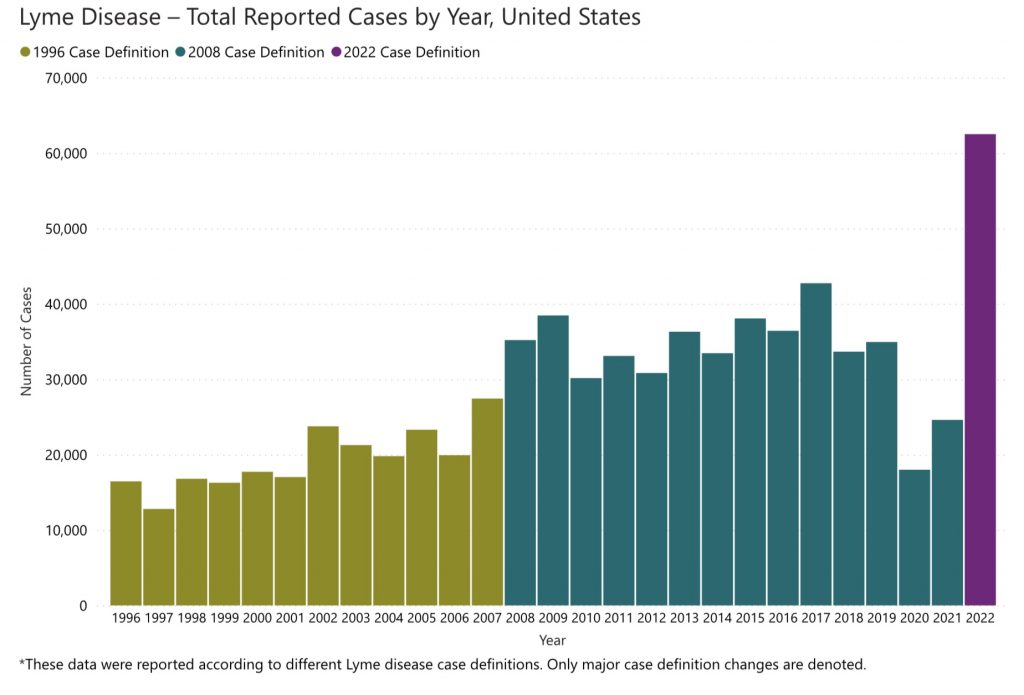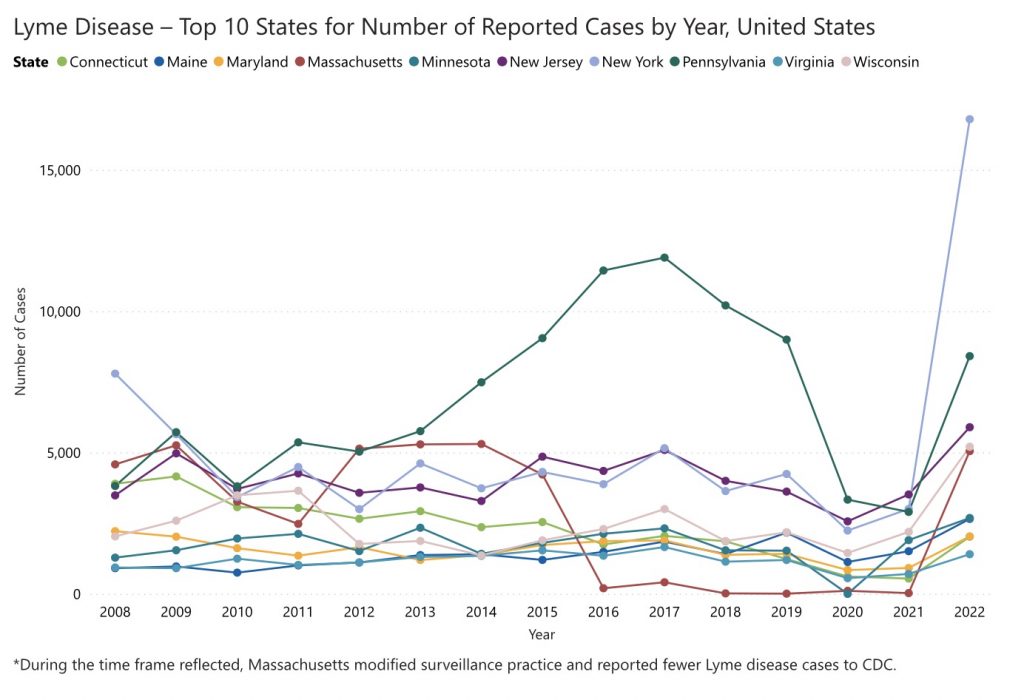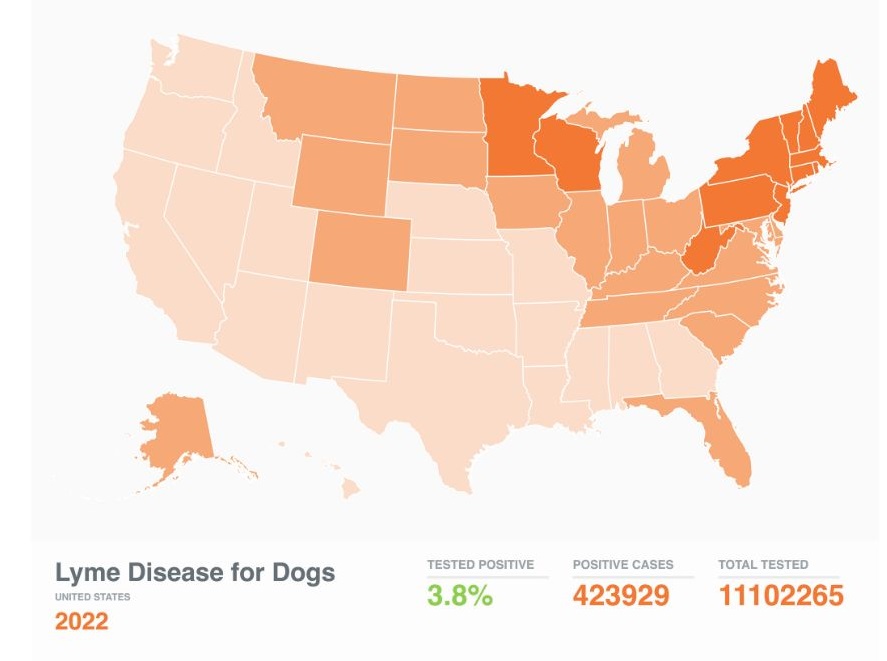True number of Lyme disease cases? We may never know.

The CDC released a surveillance report in February 2024, showing reported cases of Lyme disease rose from an average of about 37,000 from 2017–2019 to 62,000 in 2022. That’s an increase of nearly 70%. But how many people actually got Lyme disease in the US? We may never know.
The majority of Lyme disease cases are not reported to the CDC. One reason for this is because voluntary reporting standards are set by each state. Another reason is because the strict CDC reporting criteria, as set by the U.S. Council of State Territorial Epidemiologists (CSTE), requires a positive test result.
Unfortunately, the standard test for Lyme is only 50% sensitive in the early phase of disease. As the CDC states, “it is likely that current surveillance does not capture all cases of Lyme disease, specifically cases of early disease for which diagnosis is based on clinical findings alone, including presence of erythema migrans rash, and laboratory evidence is lacking because of insufficient elapsed time to mount a detectable antibody response.”
Why the whopping increase in reported cases?
Despite these hindrances, the CDC’s most recent figures show a whopping 68.5% increase in the number of reported cases of Lyme disease across all states. However, the CDC attributes the large increase in numbers due to the change in reporting criteria not an increase in new infections. They make no mention of the warmer winters or the rapid spread of ticks carrying Lyme disease in this report. (Kugeler 2022)
Knowing the surveillance criteria results in lower case counts of Lyme disease, the CDC uses other methods, including insurance claim data, to estimate the actual number of cases. For instance, in 2021 there were 24,611 Lyme cases reported to the CDC, but the CDC estimated the actual number of cases of Lyme disease was 476,000. (Kugeler 2021, Schwartz 2021)
Lyme disease cases are classified by state and local health departments according to CSTE surveillance case definitions and reported to the CDC through the Nationally Notifiable Diseases Surveillance System.
In 2022, the CDC revised its surveillance criteria definition in partnership with the CSTE. Under the new criteria, high-incidence states can report Lyme cases based solely upon laboratory evidence and no longer need to investigate and obtain clinical information for each case. (CDC 2022)
“Low-incidence” states are held to a stricter standard
Low-incidence states are still required to provide positive laboratory evidence and clinical information. (Gathering that clinical data is a cumbersome process that puts a heavy burden on local health officials.)
At the time of the 2022 reporting change, there was some speculation amongst the Lyme community that the CDC’s new Lyme case definition might result in more undercounting.
So, some may be surprised that the CDC’s latest Morbidity and Mortality Weekly Report entitled “Surveillance for Lyme Disease After Implementation of a Revised Case Definition — United States, 2022” shows a significant increase in reporting in many states.
Under the new criteria, the total number of Lyme disease cases reported to the CDC rose from an average of 37,118 between 2017–2019 to 62,551 in 2022, including 59,734 from high-incidence jurisdictions and 2,817 from low-incidence jurisdictions.


Interestingly, even with the required laboratory and clinical requirements several low-incidence states (CO, FL, GA, IN, KY, MI, MT, OH, SC, SD, WY) also saw an increase in reported cases.
The problem in California
Unfortunately, in California, where tick infection rates are as high as 31% in some coastal areas, we saw a 41% decrease in Lyme reporting. Lack of awareness and under-diagnosis is a long-standing problem for states deemed low-incidence by the CDC. (Salkeld 2021)
According to Supervising Public Health Biologist Kerry Padgett of the state Department of Public Health, “There is an under-diagnosis and under-reporting of Lyme disease in California.”
Knowing how strict the reporting criteria is, the CDC clearly states, “Surveillance case definitions are not intended to be used by healthcare providers for making a clinical diagnosis or determining how to meet an individual patient’s health needs.” Unfortunately, too many physicians rely on a faulty Lyme test rather than their ability to make a clinical diagnosis.
So how many Lyme cases are there?
In the past, the CDC has said that Lyme disease cases are underreported by a factor of 10. Meaning if there are 40,000 annual reported cases, they estimate there are at least 400,000 actual cases.
With the latest CDC report showing more than 62,000 cases of Lyme reported to the CDC does that mean we actually had 620,000 cases of Lyme in 2022?
What about canine cases?
In 2011, Paul Mead and others from the CDC published an article entitled “Canine Serology as Adjunct to Human Lyme Disease Surveillance.” In the paper, they compared CDC surveillance data on human Lyme to published veterinary data on the number of dogs who test positive. Comparing the canine data collected between 2001 and 2006 to human cases demonstrated a strong correlation. (Mead 2011) Meaning dogs who live with humans are a good sentinel for human Lyme cases.
So let’s take a look at the number of canine cases during 2022—the year the CDC reported 62,000 human cases of Lyme. In 2022 the Companion Animal Parasite Council (CAPC) reported 423,929 out of 11,102,265 US dogs tested positive for Lyme disease. This is very similar to 2021 when CAPC reported 434,091 canine cases and the CDC estimated 475,000 human cases.
While we will never know the answer to how many people were actually infected with Lyme disease in 2022 it’s safe to say there were at lease 476,000 and likely more.
LymeSci is written by Lonnie Marcum, a physical therapist and mother of a daughter with Lyme. She served two terms on a subcommittee of the federal Tick-Borne Disease Working Group. Follow her on Twitter: @LonnieRhea Email her at: lmarcum@lymedisease.org.
References
CDC’s 2022 Lyme Case Definition: https://ndc.services.cdc.gov/case-definitions/lyme-disease-2022/
Kugeler KJ, Earley A, Mead PS, Hinckley AF. Surveillance for Lyme Disease After Implementation of a Revised Case Definition — United States, 2022. MMWR Morb Mortal Wkly Rep 2024;73:118–123. DOI: http://dx.doi.org/10.15585/mmwr.mm7306a1
Kugeler KJ, Schwartz AM, Delorey M, et al. Estimating the frequency of Lyme disease diagnoses —United States, 2010-2018. Emerg Infect Dis. 2021;27(2).
Mead P, Goel R, Kugeler K. Canine serology as adjunct to human Lyme disease surveillance. Emerg Infect Dis. 2011 Sep;17(9):1710-2. doi: 10.3201/eid1709.110210. PMID: 21888800; PMCID: PMC3322085.
Salkeld DJ, Lagana DM, Wachara J, Porter WT, Nieto NC. Examining Prevalence and Diversity of Tick-Borne Pathogens in Questing Ixodes pacificus Ticks in California. Appl Environ Microbiol. 2021 Jun 11;87(13):e0031921. doi: 10.1128/AEM.00319-21. Epub 2021 Jun 11. PMID: 33893109; PMCID: PMC8316035.
Schwartz AM, Kugeler KJ, Nelson CA, et al. Use of Commercial Claims Data for Evaluating Trends in Lyme Disease Diagnoses, United States, 2010-2018. Emerg Infect Dis. 2021;27(2).





















We invite you to comment on our Facebook page.
Visit LymeDisease.org Facebook Page